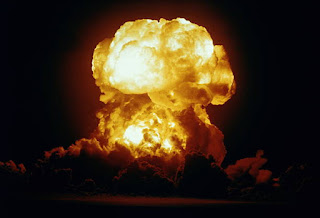An atomic weapon (otherwise called a nuclear bomb, nuclear bomb, atomic bomb or atomic warhead, and conversationally as A-bomb or nuke) is a dangerous gadget that gets its disastrous power from atomic responses, either splitting (parting bomb) or a mix of parting and combination responses (nuclear bomb), creating an atomic blast. Both bomb types discharge enormous amounts of energy from generally modest quantities of issue.
The primary trial of a splitting ("nuclear") bomb delivered a measure of energy roughly equivalent to 20,000 tons of TNT (84 TJ).[1] The first atomic ("hydrogen") bomb test delivered energy around equivalent to 10 million tons of TNT (42 PJ). Atomic bombs have had yields between 10 tons TNT (the W54) and 50 megatons for the Tsar Bomba (see TNT same). A nuclear weapon gauging just 600 pounds (270 kg) can deliver energy equivalent to more than 1.2 megatonnes of TNT (5.0 PJ).[2]
An atomic gadget no bigger than a regular bomb can obliterate a whole city by impact, fire, and radiation. Since they are weapons of mass obliteration, the multiplication of atomic weapons is a focal point of global relations strategy. Atomic weapons have been conveyed two times in battle, by the United States against the Japanese urban areas of Hiroshima and Nagasaki in 1945 during World War II.





Comments
Post a Comment